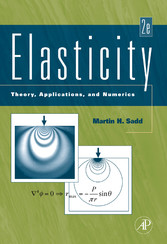Suchen und Finden
Front Cover
1
Elasticity: Theory, Applications, and Numerics
4
Copyright Page
5
Contents
6
Preface
10
About the Author
16
PART I: FOUNDATIONS AND ELEMENTARY APPLICATIONS
18
Chapter 1. Mathematical Preliminaries
20
1.1 Scalar, Vector, Matrix, and Tensor Definitions
20
1.2 Index Notation
21
1.3 Kronecker Delta and Alternating Symbol
24
1.4 Coordinate Transformations
25
1.5 Cartesian Tensors
27
1.6 Principal Values and Directions for Symmetric Second-Order Tensors
29
1.7 Vector, Matrix, and Tensor Algebra
33
1.8 Calculus of Cartesian Tensors
34
1.9 Orthogonal Curvilinear Coordinates
38
Chapter 2. Deformation: Displacements and Strains
48
2.1 General Deformations
48
2.2 Geometric Construction of Small Deformation Theory
51
2.3 Strain Transformation
55
2.4 Principal Strains
57
2.5 Spherical and Deviatoric Strains
58
2.6 Strain Compatibility
58
2.7 Curvilinear Cylindrical and Spherical Coordinates
63
Chapter 3. Stress and Equilibrium
72
3.1 Body and Surface Forces
72
3.2 Traction Vector and Stress Tensor
74
3.3 Stress Transformation
77
3.4 Principal Stresses
78
3.5 Spherical, Deviatoric, Octahedral, and von Mises Stresses
82
3.6 Equilibrium Equations
83
3.7 Relations in Curvilinear Cylindrical and Spherical Coordinates
85
Chapter 4. Material Behavior—Linear Elastic Solids
94
4.1 Material Characterization
94
4.2 Linear Elastic Materials—Hooke’s Law
96
4.3 Physical Meaning of Elastic Moduli
99
4.4 Thermoelastic Constitutive Relations
103
Chapter 5. Formulation and Solution Strategies
108
5.1 Review of Field Equations
108
5.2 Boundary Conditions and Fundamental Problem Classifications
109
5.3 Stress Formulation
114
5.4 Displacement Formulation
115
5.5 Principle of Superposition
117
5.6 Saint-Venant’s Principle
118
5.7 General Solution Strategies
119
Chapter 6. Strain Energy and Related Principles
130
6.1 Strain Energy
130
6.2 Uniqueness of the Elasticity Boundary-Value Problem
135
6.3 Bounds on the Elastic Constants
136
6.4 Related Integral Theorems
137
6.5 Principle of Virtual Work
139
6.6 Principles of Minimum Potential and Complementary Energy
141
6.7 Rayleigh-Ritz Method
145
Chapter 7. Two-Dimensional Formulation
152
7.1 Plane Strain
152
7.2 Plane Stress
155
7.3 Generalized Plane Stress
158
7.4 Antiplane Strain
160
7.5 Airy Stress Function
161
7.6 Polar Coordinate Formulation
162
Chapter 8. Two-Dimensional Problem Solution
168
8.1 Cartesian Coordinate Solutions Using Polynomials
168
8.2 Cartesian Coordinate Solutions Using Fourier Methods
178
8.3 General Solutions in Polar Coordinates
186
8.4 Example Polar Coordinate Solutions
189
Chapter 9. Extension, Torsion, and Flexure of Elastic Cylinders
232
9.1 General Formulation
232
9.2 Extension Formulation
233
9.3 Torsion Formulation
234
9.4 Torsion Solutions Derived from Boundary Equation
244
9.5 Torsion Solutions Using Fourier Methods
250
9.6 Torsion of Cylinders with Hollow Sections
254
9.7 Torsion of Circular Shafts of Variable Diameter
258
9.8 Flexure Formulation
260
9.9 Flexure Problems without Twist
264
PART II: ADVANCED APPLICATIONS
274
Chapter 10. Complex Variable Methods
276
10.1 Review of Complex Variable Theory
276
10.2 Complex Formulation of the Plane Elasticity Problem
283
10.3 Resultant Boundary Conditions
287
10.4 General Structure of the Complex Potentials
288
10.5 Circular Domain Examples
290
10.6 Plane and Half-Plane Problems
295
10.7 Applications Using the Method of Conformal Mapping
300
10.8 Applications to Fracture Mechanics
305
10.9 Westergaard Method for Crack Analysis
308
Chapter 11. Anisotropic Elasticity
314
11.1 Basic Concepts
314
11.2 Material Symmetry
316
11.3 Restrictions on Elastic Moduli
322
11.4 Torsion of a Solid Possessing a Plane of Material Symmetry
323
11.5 Plane Deformation Problems
329
11.6 Applications to Fracture Mechanics
342
11.7 Curvilinear Anisotropic Problems
345
Chapter 12. Thermoelasticity
354
12.1 Heat Conduction and the Energy Equation
354
12.2 General Uncoupled Formulation
356
12.3 Two-Dimensional Formulation
357
12.4 Displacement Potential Solution
360
12.5 Stress Function Formulation
361
12.6 Polar Coordinate Formulation
364
12.7 Radially Symmetric Problems
365
12.8 Complex Variable Methods for Plane Problems
369
Chapter 13. Displacement Potentials and Stress Functions
382
13.1 Helmholtz Displacement Vector Representation
382
13.2 Lamé’s Strain Potential
383
13.3 Galerkin Vector Representation
384
13.4 Papkovich-Neuber Representation
389
13.5 Spherical Coordinate Formulations
393
13.6 Stress Functions
398
Chapter 14. Nonhomogeneous Elasticity
408
14.1 Basic Concepts
409
14.2 Plane Problem of Hollow Cylindrical Domain under Uniform Pressure
413
14.3 Rotating Disk Problem
419
14.4 Point Force on the Free Surface of a Half-Space
424
14.5 Antiplane Strain Problems
432
14.6 Torsion Problem
435
Chapter 15. Micromechanics Applications
448
15.1 Dislocation Modeling
449
15.2 Singular Stress States
453
15.3 Elasticity Theory with Distributed Cracks
462
15.4 Micropolar/Couple-Stress Elasticity
465
15.5 Elasticity Theory with Voids
474
15.6 Doublet Mechanics
480
Chapter 16. Numerical Finite and Boundary Element Methods
490
16.1 Basics of the Finite Element Method
491
16.2 Approximating Functions for Two-Dimensional Linear Triangular Elements
493
16.3 Virtual Work Formulation for Plane Elasticity
495
16.4 FEM Problem Application
499
16.5 FEM Code Applications
501
16.6 Boundary Element Formulation
506
Appendix A Basic Field Equations in Cartesian, Cylindrical, and Spherical Coordinates
514
Appendix B Transformation of Field Variables Between Cartesian, Cylindrical, and Spherical Components
519
Appendix C MATLAB Primer
522
Appendix D Review of Mechanics of Materials
535
Index
550
Alle Preise verstehen sich inklusive der gesetzlichen MwSt.









